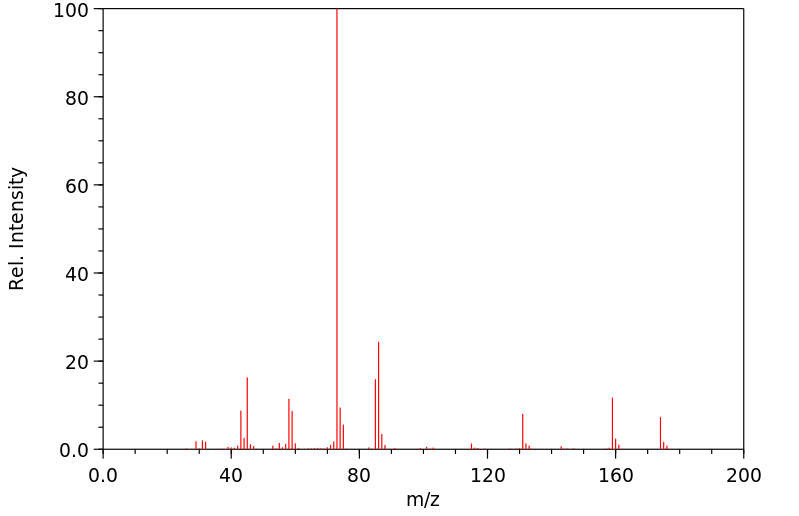1,2-bis(trimethylsilyl)ethane | 6231-76-1
中文名称
——
中文别名
——
英文名称
1,2-bis(trimethylsilyl)ethane
英文别名
Silane, 1,2-ethanediylbis(trimethyl-;trimethyl(2-trimethylsilylethyl)silane
CAS
6231-76-1
化学式
C8H22Si2
mdl
——
分子量
174.434
InChiKey
DMKCEJPDZDUPDV-UHFFFAOYSA-N
BEILSTEIN
——
EINECS
——
-
物化性质
-
计算性质
-
ADMET
-
安全信息
-
SDS
-
制备方法与用途
-
上下游信息
-
文献信息
-
表征谱图
-
同类化合物
-
相关功能分类
-
相关结构分类
物化性质
-
熔点:-30 °C
-
沸点:150-151 °C
-
密度:0.7536 g/cm3
计算性质
-
辛醇/水分配系数(LogP):3.66
-
重原子数:10
-
可旋转键数:3
-
环数:0.0
-
sp3杂化的碳原子比例:1.0
-
拓扑面积:0
-
氢给体数:0
-
氢受体数:0
SDS
上下游信息
反应信息
-
作为反应物:描述:1,2-bis(trimethylsilyl)ethane 在 三氯化铝 、 二氯二甲基硅烷 作用下, 反应 10.0h, 以12%的产率得到2-(chloro(dimethyl)silyl)-1-(trimethylsilyl)ethane参考文献:名称:Catalytic transformations of oligocarbosilanes induced by AlCl3摘要:Catalytic activation of Si-C bonds in poly(vinyltrimethylsilane) was studied using a model reaction of catalytic transformations of oligocarbosilanes Me3Si(CH2)(n)SiMe3 (n = 2, 3) in dichlorodimethylsilane in the presence of AlCl3 as an example. The formation of ClMe2Si(CH2)(n)SiMe3 Was established by chromato-mass spectrometry and GLC.DOI:10.1007/bf02495273
-
作为产物:参考文献:名称:一些双(氟二甲基甲硅烷基)烷烃的制备摘要:已经确定,通式 Me3SiRSiMe3 的双(三甲基甲硅烷基)烷烃用浓硫酸脱甲基,然后用氟化氢铵氟化,可以成功地用于通常适用于制备双(氟二甲基甲硅烷基)烷烃的方法, FMe2SiRSiMe2F。尽管在大多数情况下 Si-Me 裂解是主要反应,但部分反应在硅和 R 基团之间产生裂解。发现 R 从硅裂解的难易度按以下顺序降低:CH2,CHMe> (CH2)2>(CH2)3>(CH2)4,(CH2)5,(CH2)6>CHCl>CMe2DOI:10.1246/bcsj.37.871
文献信息
-
Air- and moisture-stable Xantphos-ligated palladium dialkyl complex as a precatalyst for cross-coupling reactions作者:Rina Takahashi、Koji Kubota、Hajime ItoDOI:10.1039/c9cc06946a日期:——xantphos has been employed in a variety of palladium-catalyzed cross-coupling reactions, there has been little progress in developing Xantphos-ligated precatalysts. In this report, we describe a Xantphos-ligated palladium dialkyl complex that acts as a powerful precatalyst for C-N, C-S, and C-C cross-coupling reactions. This precatalyst is air- and moisture stable but can be thermally activated in the
-
Silicon(II) Cation Cp*Si:<sup>+</sup>X<sup>–</sup>: A New Class of Efficient Catalysts in Organosilicon Chemistry作者:Elke Fritz-LanghalsDOI:10.1021/acs.oprd.9b00260日期:2019.11.15The catalytic activity of the pentamethylcyclopentadienylsilicon(II) cation Cp*Si:+ was investigated. It was shown that Cp*Si:+ efficiently catalyzes reactions of technical relevance in organosilicon chemistry: Cp*Si:+ proved to be a very efficient nonmetallic catalyst for the hydrosilylation of olefins at low catalyst amounts of <0.01 mol % and for the Piers–Rubinsztajn reaction in order to make controlled
-
Decamethyltitanocene hydride intermediates in the hydrogenation of the corresponding titanocene-(η<sup>2</sup>-ethene) or (η<sup>2</sup>-alkyne) complexes and the effects of bulkier auxiliary ligands作者:Jiří Pinkas、Róbert Gyepes、Ivana Císařová、Jiří Kubišta、Michal Horáček、Karel MachDOI:10.1039/c7dt01545c日期:——reactions of titanocene [Cp*2Ti] (Cp* = η5-C5Me5) and its derivatives [Cp*(η5:η1-C5Me4CH2)TiMe] and [Cp*2Ti(η2-CH2=CH2)] with excess dihydrogen at room temperature and pressures lower than 1 bar revealed the formation of dihydride [Cp*2TiH2] (1) and the concurrent liberation of either methane or ethane, depending on the organometallic reactant. The subsequent slow decay of 1 yielding [Cp*2TiH] (2) was mediated钛茂[Cp * 2Ti](Cp * =η5-C5Me5)及其衍生物[Cp *(η5:η1-C5Me4 )TiMe]和[Cp * 2Ti(η2-CH2= )]反应的1H NMR研究在室温和低于1 bar的压力下使用二氢,发现形成了二氢化物[Cp * 2TiH2](1),并同时释放了甲烷或乙烷,具体取决于有机金属反应物。随后产生的缓慢生成1 [Cp * 2TiH](2)(2)的缓慢衰变是由原位形成的并经氢气压力控制的钛茂介导的。通过在氢气存在下蒸发新鲜[Cp * 2Ti]的己烷溶液而获得的晶体产物,其晶体要么在晶胞的不对称部分具有两个独立的分子1,要么在晶体中由1和[Cp * 2Ti]组成的共晶体。 2:1的比例。在室温下进行炔烃配合物[Cp * 2Ti(η2-R1C≡CR2)]的氢化(R1 = R2 = Me或Et),得到烷烃R1 R2,除去氢后,定量地形成2。对于包含较大取代基的炔烃配合物,R1
-
A Facile Synthesis of Tetrakis(trimethylsilyl)butatriene Properties and Cycloadditions作者:Hideki Sakurai、Muneo Kudo、Kenkichi Sakamoto、Yasuhiro Nakadaira、Mitsuo Kira、Akira SekiguchiDOI:10.1246/cl.1988.1441日期:1988.8.5Tetrakis(trimethylsilyl)butatriene was readily prepared by flash vacuum pyrolysis of hexakis(trimethylsilyl)-2-butyne. The physical and chemical properties of the butatriene are described.
-
Electrosynthèse en chimie organosilicique: silylation sélective de polychlorométhanes作者:P. Pons、C. Biran、M. Bordeau、J. DunoguèsDOI:10.1016/0022-328x(88)87068-2日期:1988.12Silylation by electroreduction of carbon tetrachloride, chloroform or methylene chloride is more selective than the common organometallic route. Me3SiCCl3 (94%) and (Me3Si)2CCl2 (68%) were thus obtained from CCl4, Me3SiCHCl2 (94%) and (Me3Si)2CHCl (56%) from CHCl3 and Me3SiCH2Cl (90%) from CH2Cl2. Complete silylation of polychloromethanes was also successful by electrosynthesis and gave satisfactory
表征谱图
-
氢谱1HNMR
-
质谱MS
-
碳谱13CNMR
-
红外IR
-
拉曼Raman
-
峰位数据
-
峰位匹配
-
表征信息
同类化合物
黄原酸环癸酯
高纯三甲基锑
顺式-二氯二(环丙胺)铂(II)
顺式-二氯二(乙二胺)氯化铑(1+)
顺式-二(环己基丁氨合)二氯铂(II)
顺式-二(异丙基氨合)二氯铂(II)
顺式-(2-氨基甲基-1-环戊基氨合)二氯铂(II)
顺二氯二羰基铂(II)
顺-二氯双(乙二胺)氯化铱
雷(酸)汞[含水或水加乙醇≥20]
间碳硼烷-9-硫醇
镍,加合(7:2)钪
镉二(二戊基二硫代氨基甲酸盐)
镁,溴-6-庚烯基-
manganese carbide
butyl manganese bromide
锡烷,氯二环己基-
锡四丁醇
锑,(1:1)混合物和钪
锌叔-丁氧化物
锌,溴-1-丙烯基-,(E)-
锇,加合(2:1)钪
锆酸四丁酯
锂丁酯
锂4-异丙氧基-2-甲基-丁烷-2-醇
锂1-丁醇
锂(三氟甲基)乙炔化物
锂(3-氨基丙基)酰胺
铼五羰基碘化物
铼五羰基
银(I)2-羟基乙烷-1-硫醇盐
铯三氯三羰基锇
铬三乙二胺
铬,五羰基(环己胺)-,(OC-6-22)-
铬,二(乙酰腈)二氯-
铝,加合(3:1)钪
铜-乙二胺络合物
铜(II)乙二胺
铜(I)乙炔化物
铍,环戊-1,3-二烯,溴化
铊N,N-二正丁胺
铊,甲氧基二甲基-
铂(2+)二氯化3-甲基丁烷-1,2-二胺(1:1)
铁(3+)三(1-丁醇)
铁(2+)1,1'-(硫烷二基二-1,1-乙二基)二-2,4-环戊二烯化
铀,三甲基-
钾,[三(三甲基甲硅烷基)甲基]-
钴四异硫氰酸酯
钴,乙烷-1,2-二胺
钠辛基二硫代氨基甲酸酯







